Upon hearing the word ‘portrait’, you might immediately think of a photograph. But before portraits were captured on film, they were painted — painstakingly. Rich with frescoes, miniature paintings and countless sculptures of humans and gods, India is no stranger to the art of portrait-making. We painted portraits to record historical events as well as to project wealth, power and even grief.
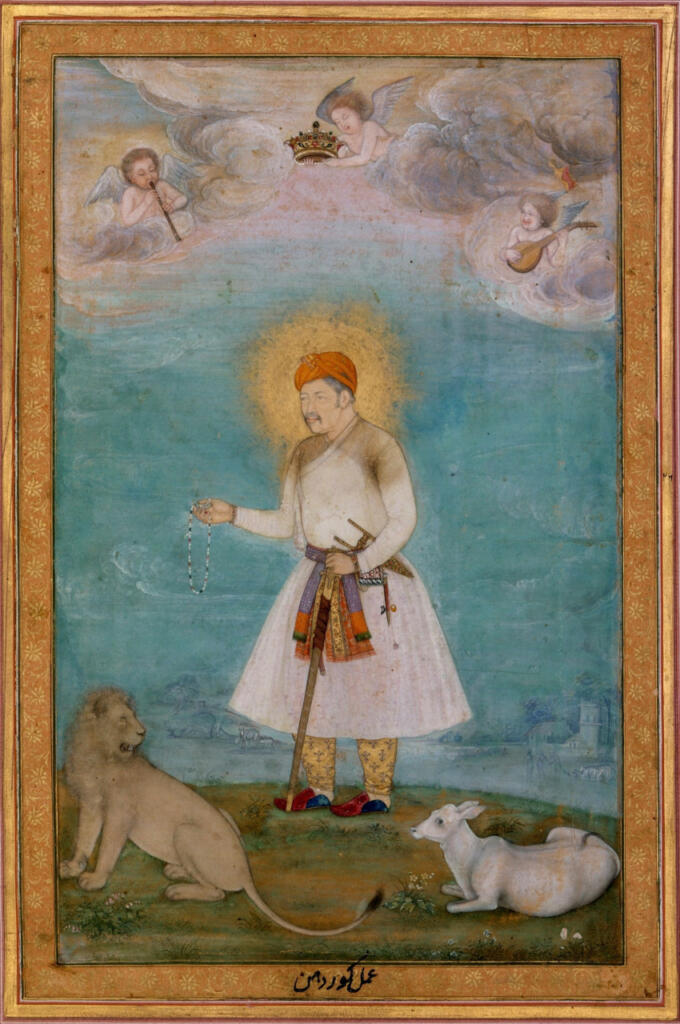
Akbar With Lion and Calf, by Govardhan, c. 1630, courtesy the Met Museum
The journey of portraiture in Indian Modern art began before Partition, when Indian artists from several institutes of Madras (Chennai), Bombay (Mumbai), Calcutta (Kolkata) and Baroda (Vadodara) experimented with European naturalistic or realistic style of painting. Some of the popular artists who painted in the European style were Raja Ravi Varma, M. V. Dhurandhar, S. L. Haldankar, M F Pithawala, Abanindranath Tagore and Jamini Roy. Gradually, with emerging movements like Impressionism or Expressionism in Europe, modern artists across the world began to reinterpret what a portrait meant. Portraits did not always have to be literal or realistic; they could be symbolic, interpretative, even abstract. Modernists in India began to gather inspiration locally and globally to create figures that were unique, expressive, unconventional. Here, we will look at four modernists from the Sarmaya collection who have created unique portraits in Indian modern and contemporary art.
FN Souza
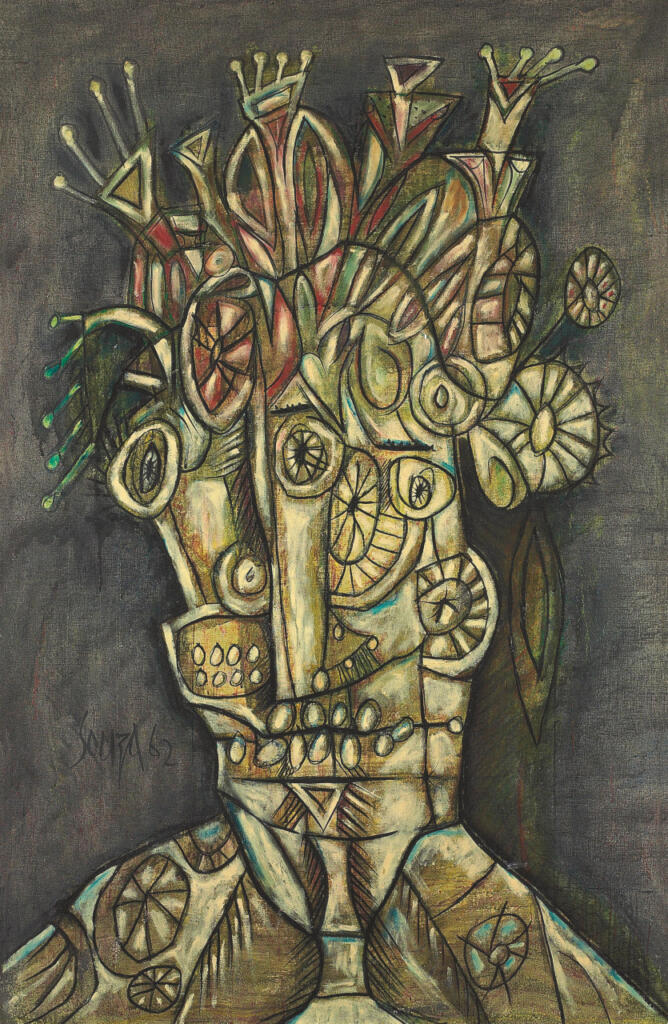
Untitled by FN Souza, courtesy Christies
Francis Newton Souza, a founder member of the Progressive Artists Group (PAG, Mumbai, 1947), in many ways shaped the Modern Art movement in India. He explored subjects like sexual interaction between men and women, the female nude and Jesus Christ, subjects which were rare in India at the time. Being an iconoclast, Souza was inspired heavily by German expressionists, a 20th-century movement that rejected all stylised and formalised art movements, laying emphasis instead on only the artist’s inner feelings. He derived inspiration from all things German and has been described by his son as a ‘Teutophile’, a person having great fondness for German culture. Other artists who inspired him were Titian, P. Cezanne, Henri Matisse and Pablo Picasso.
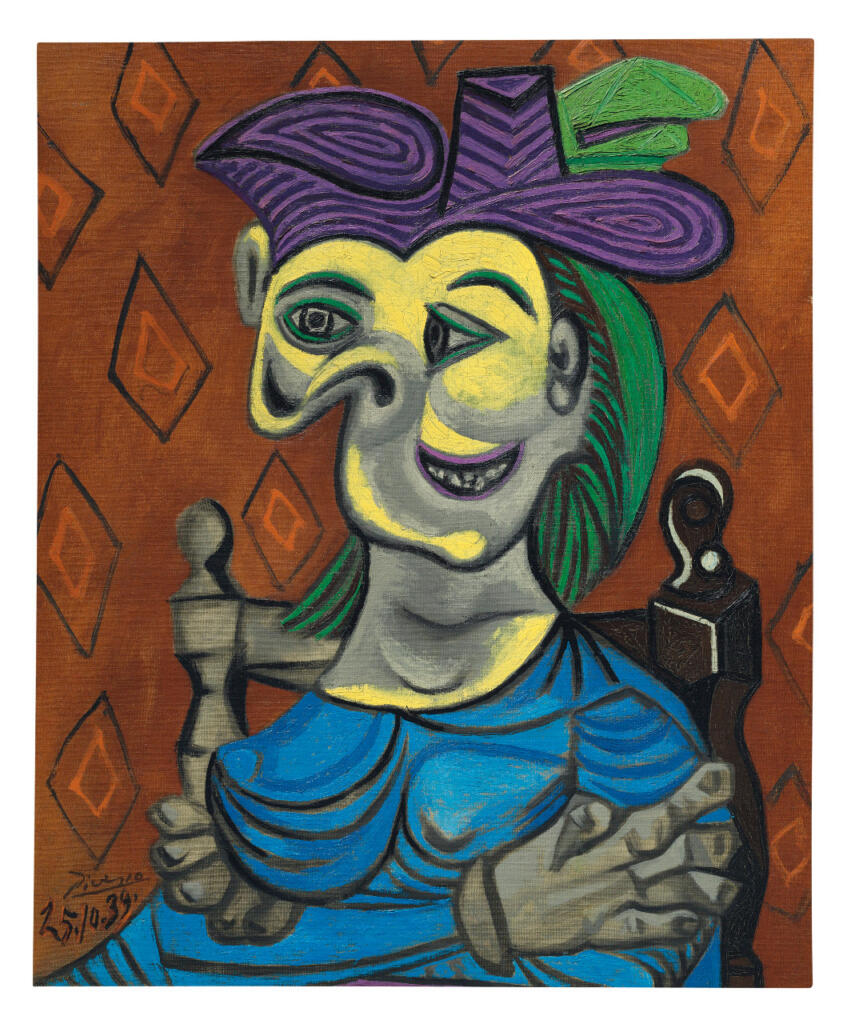
'Femme assise' by Pablo Picasso, courtesy Christies
Souza worked on his portraits like no other Indian artist. He would apply paint straight from tube to canvas, knifing or brushing it in aggressive angular strokes, and in classic Expressionist fashion would distort faces and other body parts of his subject to elicit emotions. He tended to use bold colours and lines in his paintings. The untitled work showcased here, a bust with a large head, is typical of his style. The elongated nose, bulging eyes and veins, and exaggerated teeth were all unique features of Souza’s portraits. Often the faces’ structure would bear a striking resemblance to Picasso’s busts. Souza was heavily influenced by the abstract artist, but they differed in their colour palette and in form; Souza used dark, matte, subdued colours while Picasso used bright primary colours. Souza’s lines were more fluid than Picasso’s, bearing a closer resemblance to a figure instead of having geometrical and abstract patterns.
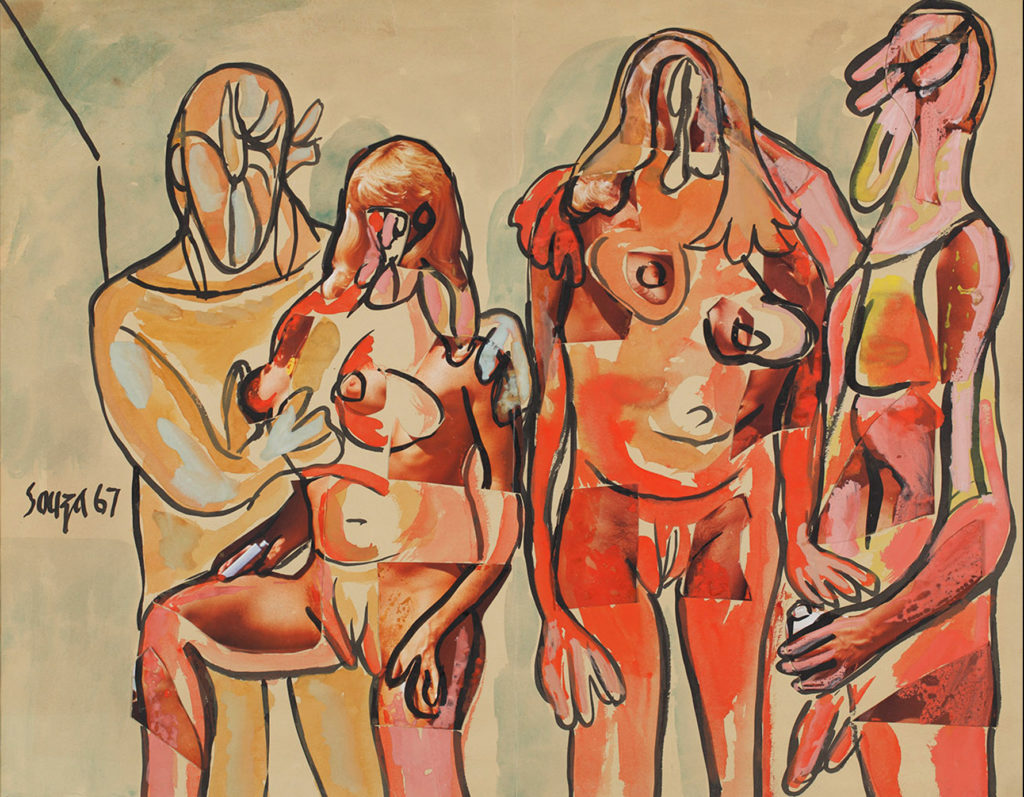
The Traders by FN Souza from the Sarmaya collection
A remarkable quality in Souza’s lines was fluidity, especially in his nude paintings which aimed to shock — and if you got past the shock, then expressed humour. Often his nudes would be painted in a frontal view, making direct contact with the viewer. The bodies would be grotesque, outlined in thick black and juxtaposed with light colours. His painting ‘the traders’ is an excellent example of this style. The facial features of these figures are missing, while their genitals are richly detailed, drawing the viewers’ eyes directly to the act of sex.
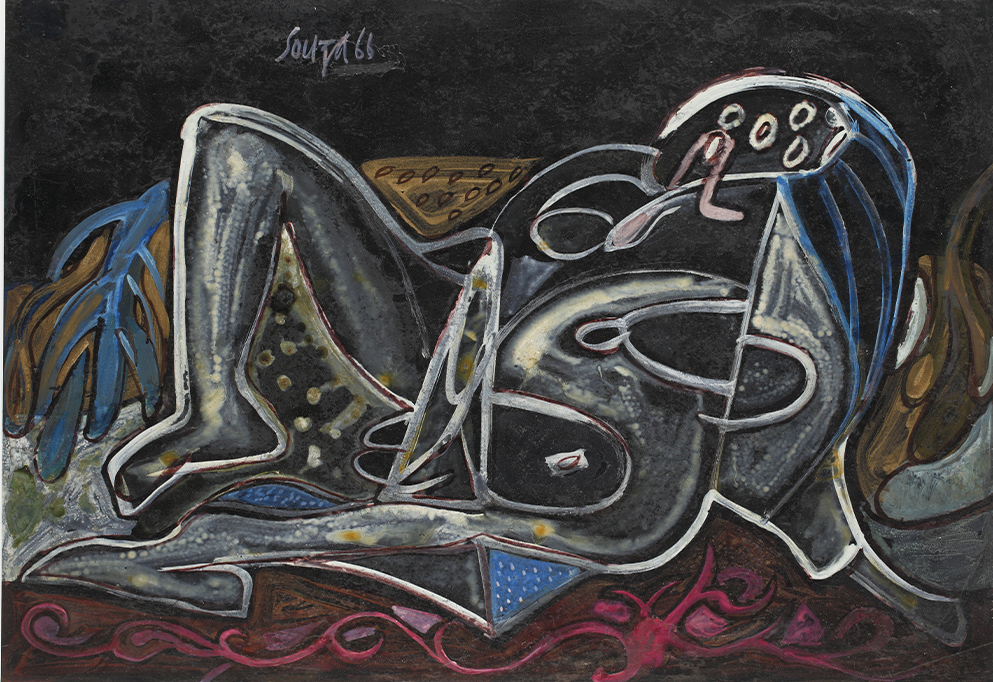
Untitled by FN Souza, 1966, mixed media on paper from the Sarmaya collection
A reverse of this technique is seen in Souza’s work as well, where a female nude appears in a black body and white outlines are used to delineate her figure. In such compositions the surroundings are often painted in sombre colours, as they are here in hues of black, pink and brown. The female nude showcased here is non-realistic/abstract, drawn in raw, bold strokes that suggest her gender and her eroticism. She displays an unfettered sexuality, her face is deliberately distorted, her tongue seems to lurch outward and her gaze is transfixed on the viewer. This directness elicits our emotions first and our intellect second. The formless brown and blue colours seen in the background suggest the ambiguity of another person being present in the canvas.
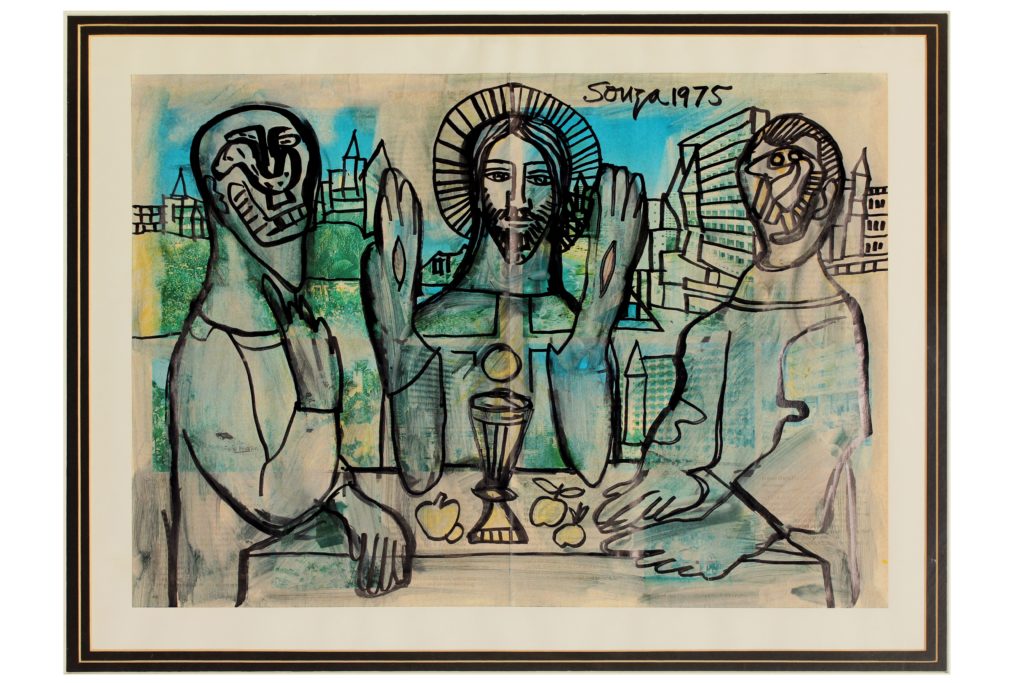
Supper at Emmaus by FN Souza from the Sarmaya collection
With his portraits Souza provides us with a window directed towards himself first and the subject second, thereby changing the dynamics of the portrait genre. Instead of flattering the subjects, his spontaneous, dark brushstrokes reveal the ugliness of all men and women. Even his Christ paintings focus on suffering rather than spirituality. “Renaissance painters painted men and women making them look like angels. I paint for angels, to show them what men and women really look like.” — Souza
Kalal Laxma Goud
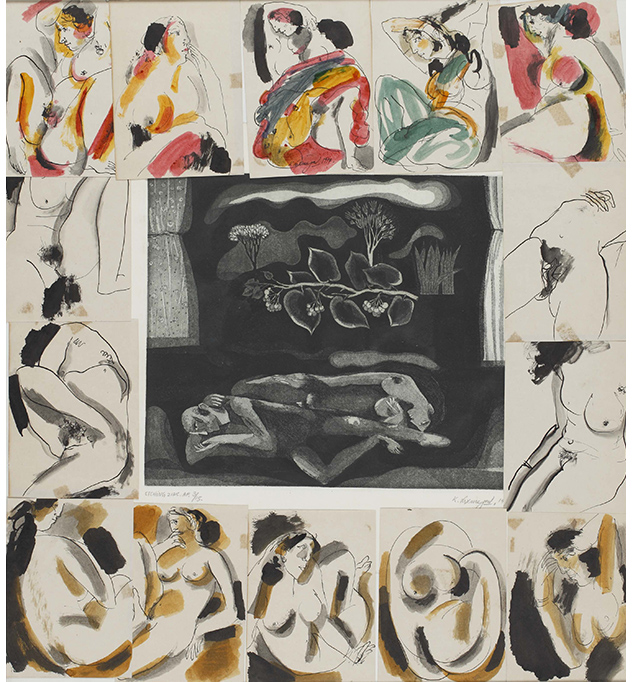
Untitled (Group of Works) by K Laxma Goud, 1974 and 1977, etching on paper; ink on paper; watercolour on paper
Laxma Goud was also fascinated by the female nude, but his subjects were rooted in the local rather than the global. Born in Nizampur, Telangana, Goud began his career under the tutelage of KG Subramanyam in Baroda’s Government college of Art and Architecture. He advocated strongly for artists to look at traditional arts and crafts for inspiration. From his early drawings Goud was known for his erotic figures, which clearly have a rustic quality to them. Always more inclined to draw women from his village because he believes the taboo of sex is absent in the villages of India, in contrast to urban life. Goud's nude figures were often entwined with an animal or bird, or the foliage of the forest, giving his world a dreamlike, surreal quality. He emphasises that his nude art was heavily inspired by village festivals and theatre performances he saw as a child.
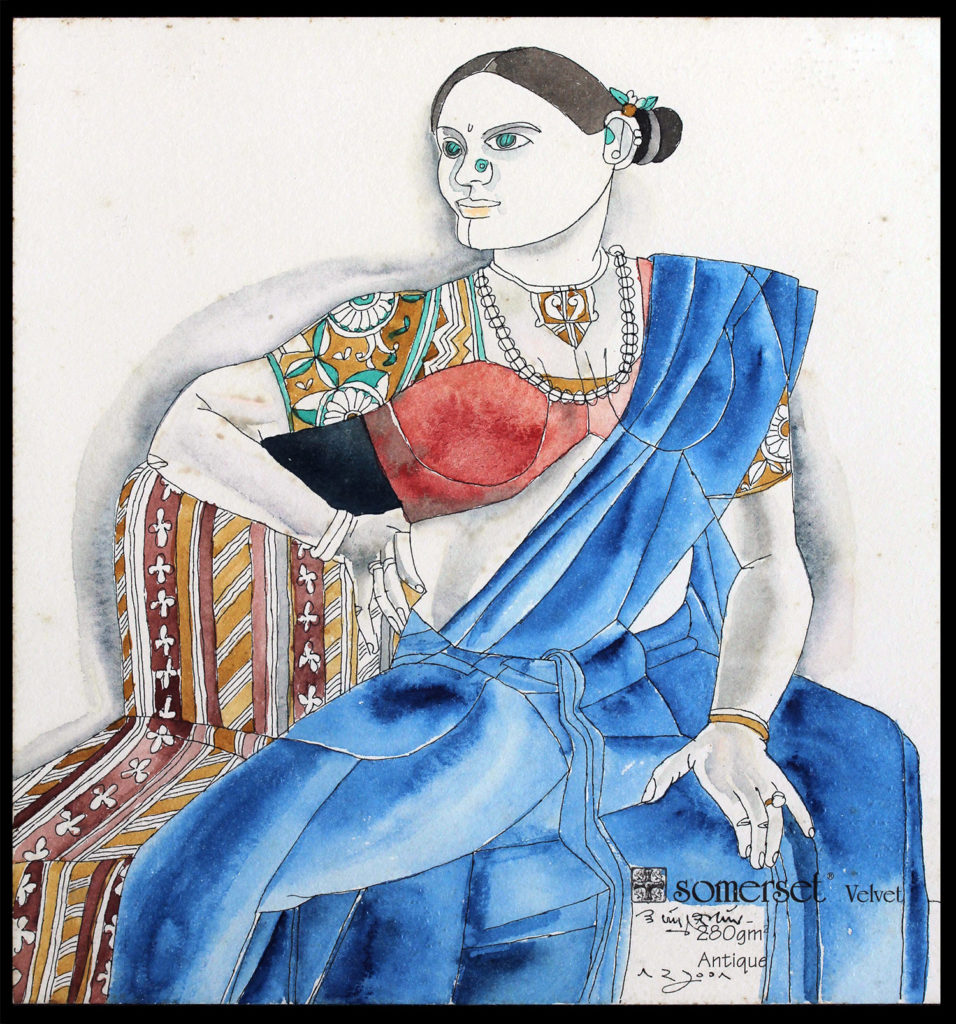
Untitled, watercolour on paper, by Laxma Goud from the Sarmaya collection
With time, the eroticism in Goud’s art became subtle and nuanced. His women would be drawn with a sexual energy but they would rarely appear nude, as can be seen in his watercolour series. The women’s bodies are carefully defined, their breasts and nipples outlined even though they are wearing blouses. Goud adds characteristic jewellery and motifs on the sarees creating a spot-on typology of the rural women of Telangana. The postures and hand gestures of several of these women indicate their powerful personality, taking the viewer by surprise. Goud uses watercolour only for bodily ornamentations and additional furniture, leaving the body and the background of the canvas white. Goud had always been fascinated by white and black as well as the greys in between. He believes that monochrome can speak as much as colour does.
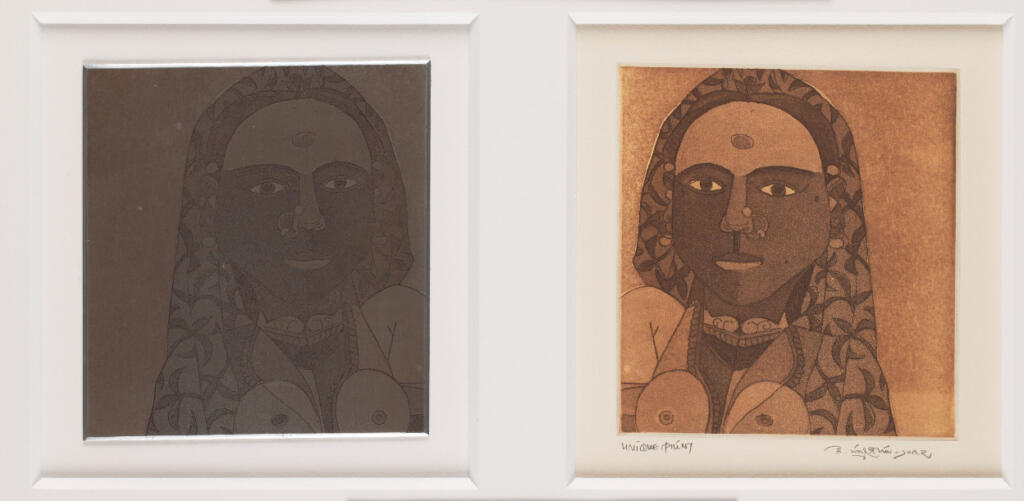
Untitled, etchings with accompanying plates, 2012, by K Laxma Goud
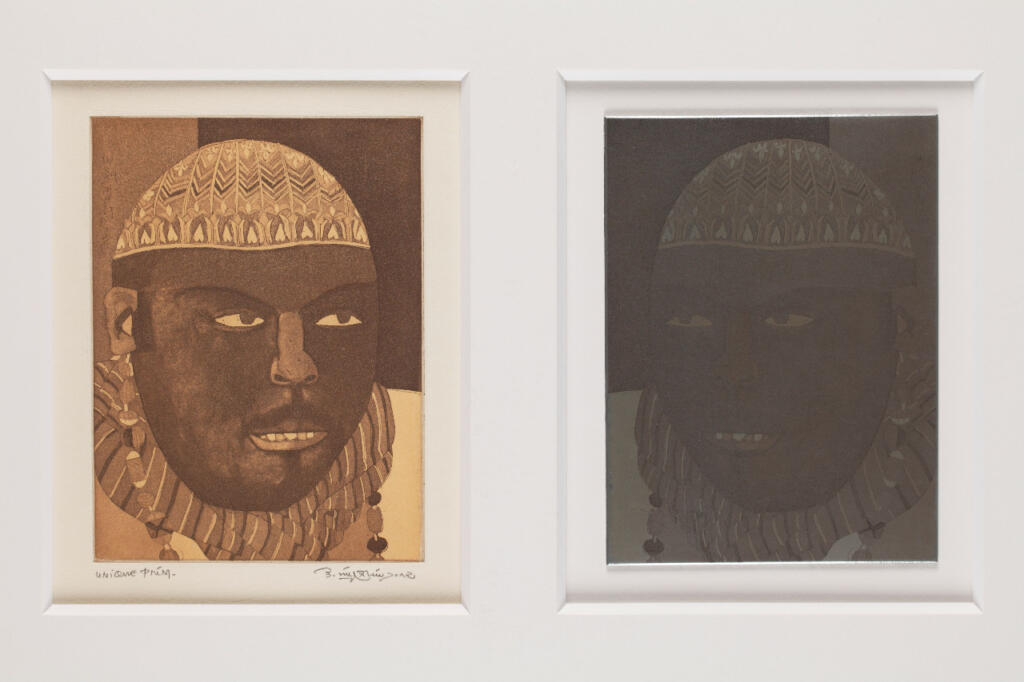
Goud is a master of many mediums. He works with drawings, etchings, silkscreen, watercolours and gouache, as well as clay, ceramic, terracotta and bronze sculptures. He took to printmaking shortly after he graduated from Baroda School, and says he draws immense pleasure from the medium, the tools and especially the drawing of the line. “The purity of the line, the purity of the print… it’s very sensuous.” In his plates and prints shown above, he plays with monochrome creating several layers of greyish black between his pure black and pure white. The whiteness of the eyes creates a striking contrast to the rest of the image. He wants to seduce his audience with these pure lines. With every new medium he has also moved towards creating endearing and playful bust portraits of the people of rural Telangana.
Dhruvi Acharya

Float by Dhruvi Acharya, courtesy Dhruvi.com
In stark contrast to the previous two artists, Dhruvi Acharya’s paintings portray the urban woman. She creates a canvas that most often depicts a comic-like female figure in a visual world unique to each painting. In this world thoughts exist as real entities and the human forms take on aspects of their emotional personalities. Often these figures are represented with blank expressions, empty thought and blank speech bubbles, in her later works the speech bubbles were replaced by chatter mouths. Acharya adopts nuances like these to convey her dark humor and satire, in order to provoke the viewer towards thinking about the realities of her protagonist’s life.
Acharya was always interested in drawing and creating illustrations. In 1998, she studied fine art from Maryland Institute College of Art, Baltimore USA. After returning to India, it took her three years to exhibit her work in Mumbai’s Jehangir Art Gallery. She derives her inspirations from Indian miniatures, comic books like Amar Chitra Katha and contemporary street art.

2019.2.16 Untitled (Somnolent), Pencil drawing, 2004, Dhruvi Acharya from the Sarmaya collection
In her pencil work, we see a woman lying on her bed with a book in her hands, but her eyes wander elsewhere and from her head pops up a thought bubble. In 2006, Dhruvi recreated this image in colour, titled ‘Somnolent’. In this painting, one is instantly aware of the influence of comic books because of the way the image is readable to the audience. First, we see the subject, then we look at her eyes and then finally we notice the thought bubble. In the art world, choosing to draw a woman who is not mystic, sensuous or divine is, even today, unconventional. Acharya’s women are real and relatable, and range across ages. She does not portray women who have defined figures, sometimes they are shown as imperfect figures who carry heavy, tired old eyes which I imagine is how all urban women feel on the inside.
In another painting, we see the woman lying in her bed with a cloud of thought bubbles patterned in lines or circles. On one hand she holds a pencil and on the other a blank sheet of paper. The bed is a common object used in the universe of Dhruvi Acharya, often used as a space for contemplation, solace and grief. The empty thought bubbles represent the thoughts of women that are never spoken out loud. This drawing may have been autobiographical, as the artist admits that her earlier drawings have been based on herself. Even today, she takes inspiration from everyday life and interactions.
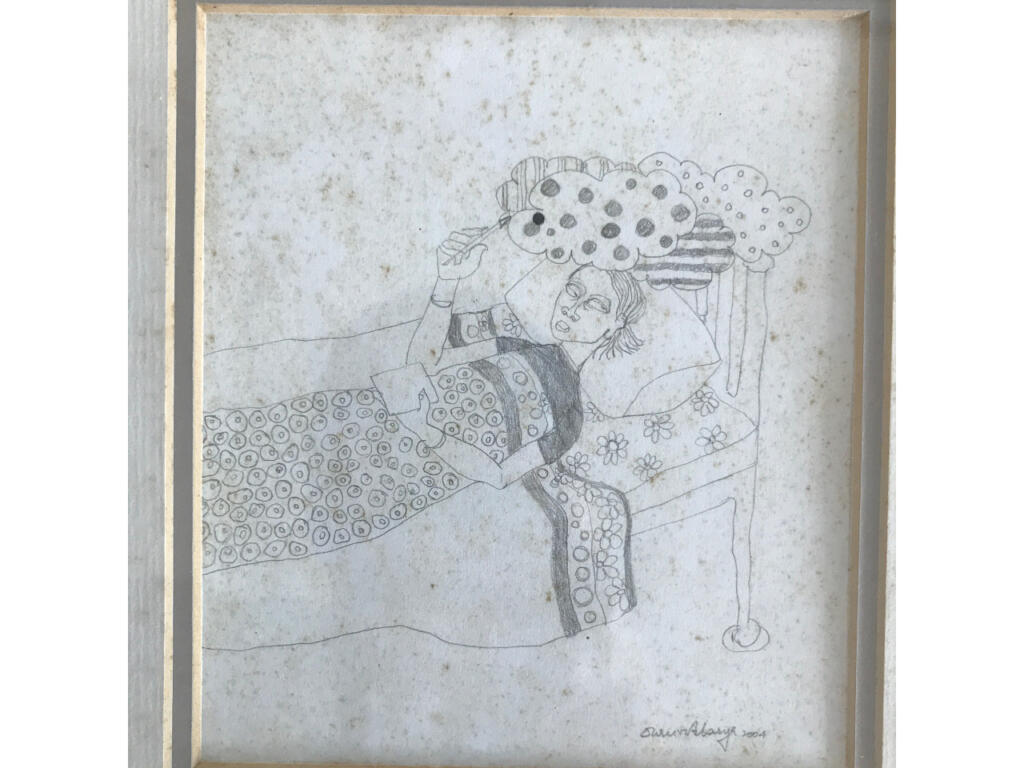
Untitled (Woman lying on the bed), Pencil on paper, 2004, Dhruvi Acharya from the Sarmaya collection
The untitled work of a ‘flower stem wrapped around a woman’ features a woman dressed in a long shapeless dress, her face white and expressionless, as is typical of Acharya’s style. The figure looks up at the protruding blue bump attached to her head, a contraption that is watering the flower wrapped around her body. The 2007 painting seems to be the predecessor of Acharya’s 2008 show based on environmental concerns. In the show, she imagines a world where there is no clean air to breathe, as a result of which the human figures have mutated to be half-plant and half-human, thereby creating the air they breathe themselves. But not all humans have evolved thus, leading inevitably to a battle between the haves and the have-nots.
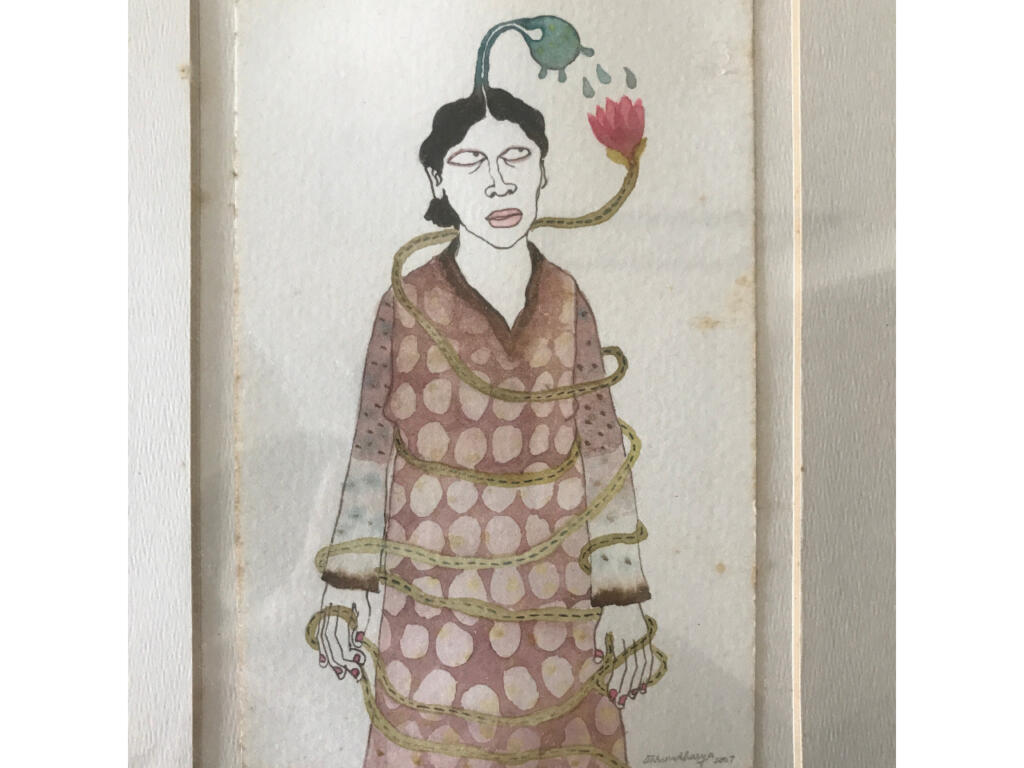
Untitled (Flower stem wrapped around a woman), watercolour on paper, 2007, Dhruvi Acharya from the Sarmaya collection
The expressionlessness of the figures leaves the viewer bewildered, especially given the theme the portrait represents. This is Acharya inciting humour in grave, serious issues. Her portraits have a refreshing new language that is unlike any others in the art world, with figures that are quirky and strange while at the same time dark and symbolic.
Alexander Gorlizki in collaboration with Riyaz Uddin
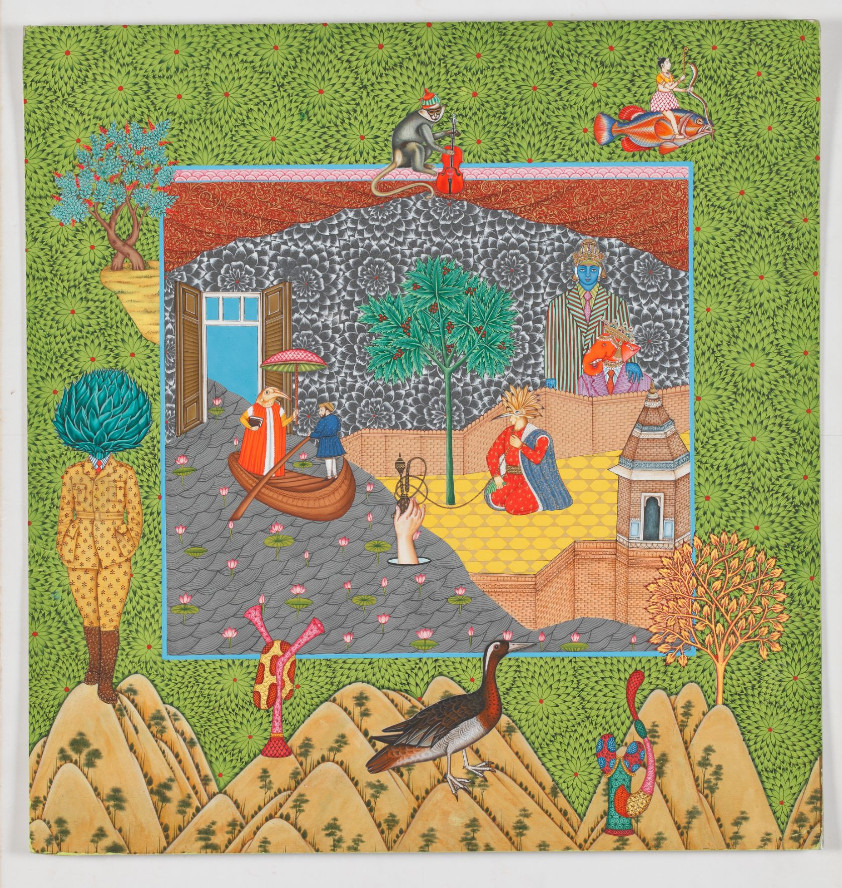
'Let's get it rolling', pigment and gold on handmade canvas, 2019, Alexander Gorlizki and Riyaz Uddin
British-born artist Alexander Gorlizki creates his own dream world with the miniature master artist Riyaz Uddin. Together they paint over family portraits, borrowing from the tradition of painted photography, an art form prevalent in India during the 20th century. Miniature artists were requested to colour in the black and white photographs taken at the time. Gorlizki draws the composition of the painting, indicating where and how he wants his subjects in the photograph, and Uddin paints this composition with his jewel-coloured pigments with unbelievable intricacy. Gorlizki and Uddin work on each piece simultaneously by sending it back and forth for modifications, the process sometimes taking a year to be completed.
Gorlizki completed his formal Fine Art education at Bristol Polytechnic, followed by an MFA in Sculpture from the Slade School in London. He currently lives and works in New York City. Heavily inspired by Indian miniature paintings and traditional Indian Mughal folios, he has reinterpreted these traditional art forms to create his own personal visual language. In the mid-1990’s Gorlizki decided to open up a studio in Jaipur, which is when the collaboration with Uddin began.
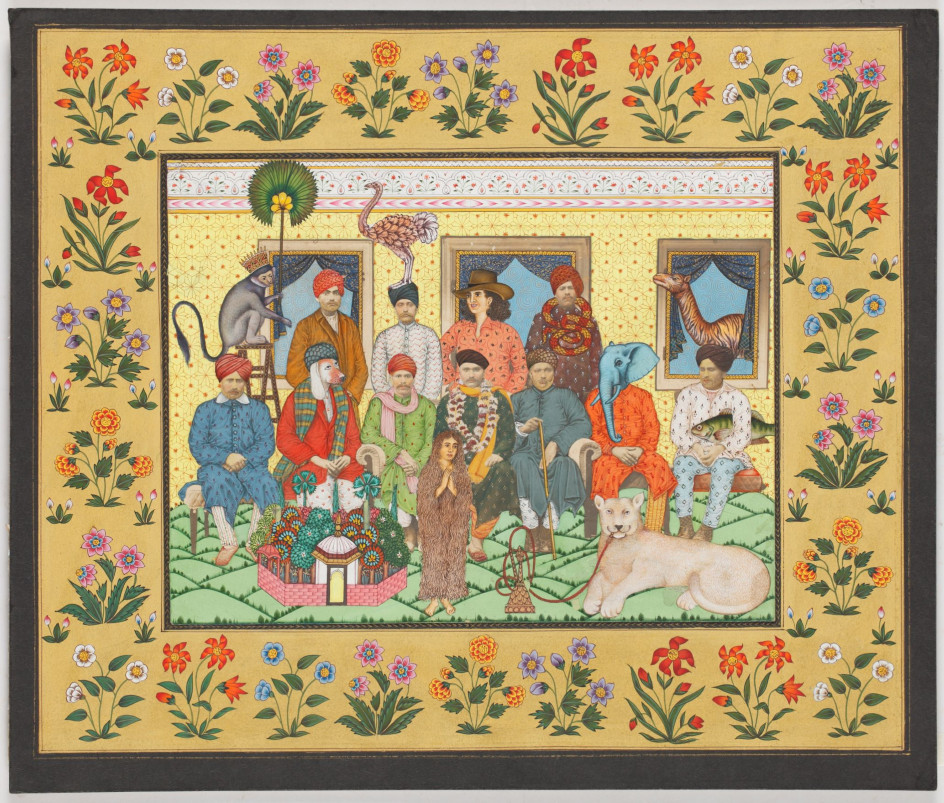
The waiting game, Pigment and Gold on photograph printed on cardboard, 2016, by Alexander Gorlizki and Riyaz Uddin from the Sarmaya collection
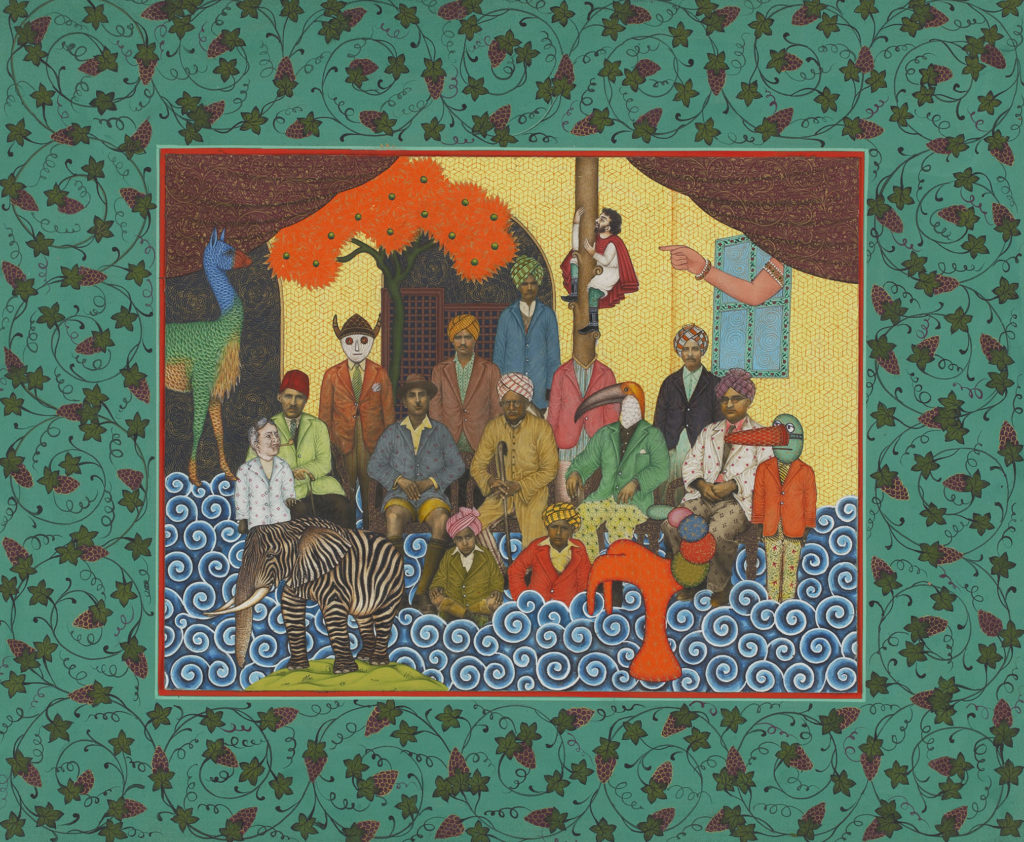
'Gathering on a Family Farm', 2017 by Alexander Gorlizki—click on the image to read more
‘Gathering of a family farm’ is a typical example of how Gorlizki toys with and expands the idea of painted photography and family portraiture. In this painting, characters appear to be posing for a photograph as most of them are seated and directly gazing at the viewer. There is only one woman, elderly and smoking a pipe, and the only other feminine aspect is that of the oversized jewellery-clad arm sticking out of the window. The characters have human bodies but animal faces, showcasing a predominant theme of whimsy and transcendental life. Even the animals in the painting are disguised as other animals; the llama appears to be a peacock and the elephant a zebra. Yet even with all these abnormalities, the humans look strangely composed. This gives the painting a collage-like appearance, almost as if the photograph is the wall and the painting done on it is graffiti.
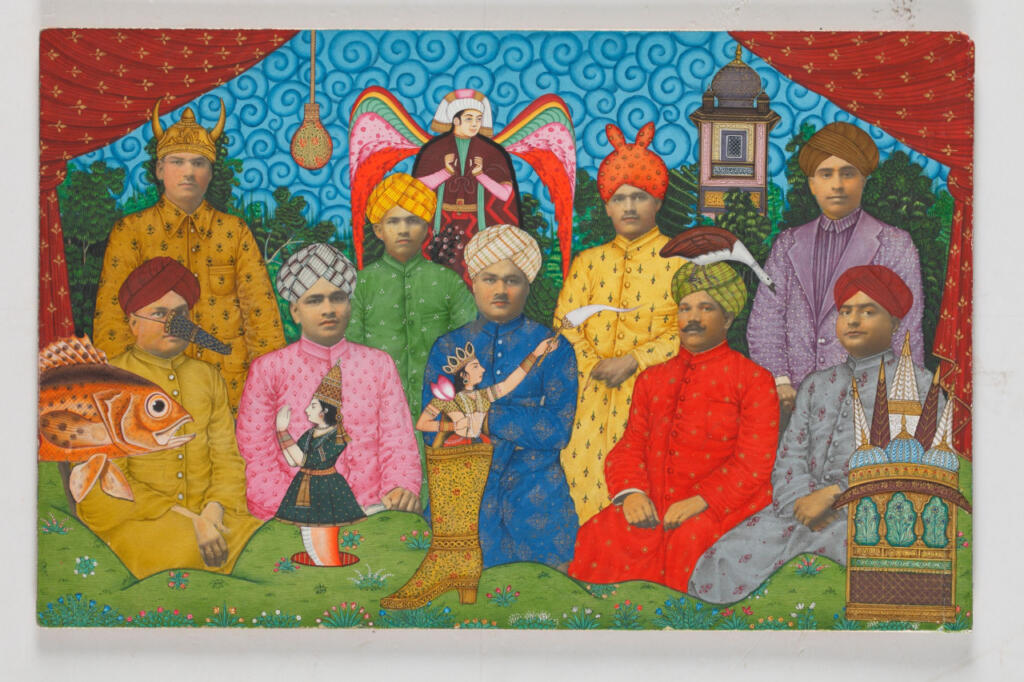
The Interview Panel, pigment and gold on photograph printed on cardboard, 2019, by Alexander Gorlizki and Riyaz Uddin from the Sarmaya collection
The compositions, colours and intricate patterns drawn on the family portraits bring alive the static studio image and liberate the subjects from the stoic stillness they had to maintain during studio photographs. The pop colours used to detail the photograph have brought to light the potential of miniature art as a tool for satire and as Pop art. For example, there is a lingering satirical element in this painting, which is conveyed by the angelic figure painted above all others, the subject on the far left being depicted with horn headgear et al. Gorlizki says that he plays with portraits to this extent so that they become narrative works. So the family portrait evolves from a memory to a story, and because the story is open to interpretation, it creates stories in multitude.
To portray or to depict is the first step an artist takes in his or her practice, which is why the art of portraiture is as old as art itself, and as timeless. It has endured through the decades, remains as relevant in contemporary times and will no doubt take on new forms in an ever-changing future.
References
- F.N. Souza, published by Dhoomimal Gallery
- Why Souza matters, livemint article
- The Drawings of Souza and Picasso- A meeting of two artistic Giants, Saffronart blog
- Art of Francis Newton Souza: A study using the Psycho-analytical Approach, by Ratan Parimoo
- Wormholes to Goud’s universe, The Hindu- Business Line
- A life in line and colour, The Hindu
- Self discovery through art, The Asian Ace
- 2012, The Art of K. Laxma Goud, New Delhi: Art Alive Gallery
- Woman interrupted: Dhruvi Acharya’s exhibition on death and female interpretation, The Hindustan Times
- Dhruvi Acharya Website
- IGTV Sarmaya
- Vadodara: This exhibition weaves new narratives with miniature paintings, textiles and products, Architecture Digest
- We are one- Alexander Gorlizki, Galerie Eric Mouchet.



